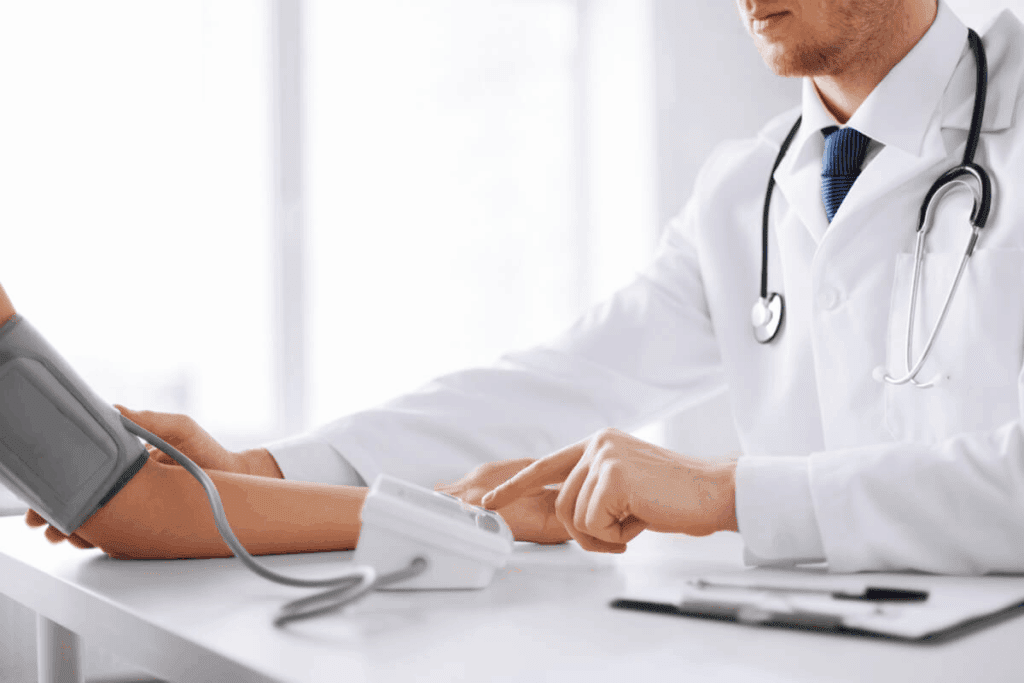
Have you noticed swelling in your neck and wondered what it means? Enlarged cervical lymph nodes, also known as cervical lymphadenopathy, are common. They affect the lymph glands in the neck. What causes enlarged cervical lymph nodes? Learn about the common infectious and non-infectious causes of swelling in the neck.
At Liv Hospital, we know swollen lymph nodes can signal an infection or a serious issue. We look into causes like infections or cancer. Our goal is to give you the right diagnosis and treatment.

Cervical lymph nodes are small, kidney-shaped organs in the neck. They help fight infections. Knowing about them is key to our health.
Cervical lymph nodes are part of the lymphatic system. This system defends the body against infections. They are in the neck to filter lymph fluid from the head and neck.
Key locations of cervical lymph nodes include:
Lymph nodes, like those in the neck, are vital for the immune system. They filter out pathogens and start the immune response. This includes making antibodies and activating immune cells.
“Lymph nodes are critical for the immune system’s ability to detect and respond to pathogens. Their role in filtering lymph fluid and trapping harmful substances is vital for maintaining health.”
Normally, cervical lymph nodes are small, less than 1 cm in diameter. They are usually not felt or seen during a physical exam. If they get bigger, it might mean there’s an infection or health problem.
Characteristics | Normal Lymph Nodes | Abnormal Lymph Nodes |
Size | Less than 1 cm | Greater than 1 cm |
Texture | Soft, smooth | Hard, irregular |
Tenderness | Non-tender | Tender |
Knowing what normal cervical lymph nodes look like is important. If they’re big or sore, it could mean a health issue. This could be anything from an infection to a more serious problem.

Swollen lymph nodes in the neck can mean an infection, inflammation, or other issues. Enlarged cervical lymph nodes, or cervical lymphadenopathy, signal something might be off. We’ll show you how to spot these nodes and what they might mean.
Cervical lymphadenopathy is when neck lymph nodes get bigger. It can happen for many reasons, like infections, autoimmune diseases, or cancers. Knowing what causes cervical lymphadenopathy helps figure out why lymph nodes swell.
Finding swollen lymph nodes involves a physical check-up and sometimes more tests. Swollen lymph nodes can be tender and painful to the touch. Here’s how to find them:
Telling normal from abnormal lymph node growth is key. Normally, lymph nodes aren’t easy to feel. But during an infection, they can swell and then go back to normal once the infection clears. Abnormal growth stays or comes with other worrying signs. The main differences are:
Characteristics | Normal Enlargement | Abnormal Enlargement |
Duration | Temporary, resolves with infection | Persists or grows over time |
Associated Symptoms | Mild tenderness, resolves on its own | Pain, fever, weight loss, or other systemic symptoms |
Spotting enlarged cervical lymph nodes and knowing when they’re serious can lead to getting medical help. If you see persistent or odd swelling in your neck, see a doctor.
It’s important to know why cervical lymph nodes get big. This helps doctors find and treat the problem. Big lymph nodes often mean there’s an infection.
Viruses are a big reason for big lymph nodes. Viruses like Epstein-Barr, cytomegalovirus, and HIV can make lymph nodes swell. For example, Epstein-Barr virus causes big lymph nodes in young people.
Measles and rubella can also make neck lymph nodes swell. These nodes usually go back to normal once the infection goes away.
Bacteria can also make lymph nodes big. Streptococcus pyogenes, the germ behind strep throat, is a common cause. The body gets inflamed and the nodes get bigger as it fights the germ.
Other bacteria, like Staphylococcus aureus and Mycobacterium tuberculosis, can also cause big lymph nodes. Tuberculosis can make nodes very big and sometimes they get infected.
Other things like fungi and parasites can also make lymph nodes big. Fungal infections, like histoplasmosis, and parasitic infections, like toxoplasmosis, can cause this. It’s the body’s way of fighting off the infection.
Most of the time, big lymph nodes are not serious. Studies show that in adults and kids, they usually get better on their own or with treatment. Common causes include strep throat, measles, ear infections, and mononucleosis.
Inflammatory and autoimmune disorders can cause big changes in the body. This includes swelling in the cervical lymph nodes. These conditions happen when the immune system attacks healthy tissues by mistake.
Several autoimmune diseases can make cervical lymph nodes swell. We will look at how these diseases affect lymph nodes and why getting a correct diagnosis is important.
Rheumatoid arthritis (RA) is a chronic autoimmune disorder that mainly affects joints. But it can also cause inflammation in other parts of the body, like the lymph nodes. In some cases, RA can make the lymph nodes in the neck swell.
The exact reason behind RA-related lymphadenopathy is complex. It involves the immune system reacting abnormally. Early diagnosis and treatment are key to manage symptoms and prevent complications.
Systemic lupus erythematosus (SLE or lupus) is another autoimmune disease that can make cervical lymph nodes swell. Lupus can cause a variety of symptoms, including joint pain, skin rashes, and kidney problems.
Lymphadenopathy is common in lupus patients, often happening when the disease is active. Managing lupus effectively is important to reduce the risk of lymph node enlargement and other complications.
Sarcoidosis is a condition where granulomas (inflammatory cells) form in various parts of the body, including the lymph nodes. It can cause cervical lymphadenopathy, along with symptoms like cough and shortness of breath.
The exact cause of sarcoidosis is unknown, but it’s believed to involve an abnormal immune response. Treatment focuses on managing symptoms and reducing inflammation.
Kawasaki disease is an acute condition that mainly affects children. It causes inflammation in the blood vessels and can lead to cervical lymphadenopathy. It is characterized by fever, rash, and swelling of the hands and feet.
Prompt medical attention is essential for managing Kawasaki disease and preventing long-term cardiovascular complications.
Understanding these inflammatory and autoimmune causes is vital for proper diagnosis and management. Certain risk factors, such as male gender, increasing age, and shorter duration of lymphadenopathy, warrant careful evaluation.
Accurate diagnosis and appropriate treatment of these conditions are critical. They help manage symptoms and improve patient outcomes.
Enlarged cervical lymph nodes can signal serious health issues. These include lymphomas and metastatic cancer. Knowing these causes helps in early treatment.
Lymphomas start in the lymphatic system. They make neck lymph nodes swell. There are two main types: Hodgkin and non-Hodgkin lymphoma. Both can cause swollen lymph nodes in the neck.
Metastatic cancer happens when cancer spreads to the neck lymph nodes. It often comes from head and neck, thyroid, or breast cancers. Finding metastatic cancer in these nodes means the disease is advanced.
Cancers in the head and neck can spread to cervical lymph nodes. These include squamous cell carcinoma and nasopharyngeal carcinoma. Swollen lymph nodes might be the first sign of these cancers.
Some factors raise the risk of cancer in swollen lymph nodes. These include male gender, increasing age, and shorter duration of lymphadenopathy. Knowing these can help catch cancer early.
Cancers like lymphoma, leukemia, and metastatic cancer can make lymph nodes swell. Quick medical action is key to better outcomes.
Swollen cervical lymph nodes often come with various symptoms. It’s important to know these signs to figure out the cause and what to do next.
Local symptoms happen near the swollen lymph nodes. These include:
These signs show the body’s fight against infection or inflammation. Sometimes, the swelling can be so big it hurts or makes it hard to swallow.
Systemic symptoms affect the whole body. They can point to a bigger problem. Common signs include:
These signs might mean an infection, autoimmune disease, or cancer. If they don’t go away or get worse, see a doctor right away.
Some symptoms need quick medical help because they might mean serious issues. These include:
Symptom | Potential Indication |
Severe pain or swelling | Possible abscess or severe infection |
Difficulty breathing or swallowing | Potential airway obstruction |
High fever unresponsive to treatment | Severe infection or sepsis |
Unexplained weight loss | Possible malignancy |
Knowing these symptoms and when to get medical help is key. It helps get the right care on time.
Getting an accurate diagnosis is essential to find out why cervical lymph nodes are swollen. This helps us choose the right treatment. We’ll look at how doctors diagnose swollen lymph nodes in the neck.
A detailed physical check is the first step to diagnose swollen lymph nodes. We measure the size, feel if they’re tender, and check their texture. We also look at the head and neck for any signs of infection or cancer.
Laboratory tests are key to figuring out why lymph nodes are swollen. Tests include:
Imaging studies help us see the lymph nodes and what’s around them. Common ones are:
Imaging Modality | Use |
Ultrasound | To check the size and details of lymph nodes. |
CT Scan | To see how big the swelling is and if there are any tumors. |
MRI | To get clear pictures of soft tissues and lymph nodes. |
In some cases, a biopsy is needed to find out why lymph nodes are swollen. We might do a fine-needle aspiration biopsy or an excisional biopsy, depending on the situation.
It’s important to know when to see a doctor for swollen lymph nodes in your neck. These nodes can grow for many reasons, from simple infections to serious diseases. So, knowing when to get medical help is key for your health.
Some symptoms mean you need to see a doctor fast. Trouble swallowing or breathing is a big warning sign. Other signs include:
At your doctor’s visit, you’ll get a detailed check-up. First, your doctor will examine the lymph nodes. They’ll look at their size, tenderness, and other details. Your doctor will also ask about your health history and any recent infections.
Based on what they find, your doctor might do laboratory tests like blood work. They might also use imaging studies like ultrasound or CT scans to look closer at the nodes and tissues around them.
After your treatment starts, regular check-ups are important. Your doctor will keep an eye on the lymph nodes and any other health issues. They’ll also watch for new symptoms. Your doctor will tell you how often to come back for visits based on your situation.
Following your doctor’s advice for follow-up care is vital. It helps manage any health problems and prevents bigger issues.
It’s key to understand and manage cervical lymphadenopathy for good health. Swollen lymph nodes in the neck might mean there’s an issue that needs a doctor’s help. Usually, it means your body is fighting off an infection.
We’ve looked at why cervical lymph nodes get big, like infections, inflammation, or cancer. Knowing the signs of swollen lymph nodes is important. This helps you know when to see a doctor.
Handling cervical lymphadenopathy well means getting a proper diagnosis and treatment. Doctors can figure out why your lymph nodes are swollen. Then, they can plan the right treatment, like antibiotics or anti-inflammatory drugs.
Getting help quickly is important to avoid serious problems. We stress the need to see a doctor if symptoms don’t go away or get worse. By being proactive about your health, you can catch and treat any issues early.
Cervical lymph nodes are part of the immune system in the neck. They help filter lymph fluid and catch pathogens.
Cervical lymphadenopathy is when these nodes get bigger. It can happen due to infections, diseases, or cancer.
To find swollen lymph nodes, gently feel for lumps or tender spots. Knowing what normal and abnormal enlargement looks like helps.
Viral and bacterial infections, and other pathogens can cause these nodes to swell.
Yes, diseases like rheumatoid arthritis, lupus, and sarcoidosis can make these nodes bigger.
Yes, they can be a sign of cancer, like lymphomas or metastatic cancer. Getting medical help quickly is key.
Symptoms include swelling, pain, fever, and fatigue. Some symptoms need urgent medical care.
Doctors use physical exams, lab tests, imaging, and biopsies to find the cause.
See a doctor if you have big swelling, pain, or trouble swallowing. Also, if you have fever or lose weight.
Expect a full exam, talk about your health history, and possibly more tests to find the cause.
Follow-up care helps track the condition, adjust treatments, and manage any underlying causes.
It’s vital to address the cause, ease symptoms, and improve health outcomes.
Risk factors include a cancer history, exposure to carcinogens, and certain genetic mutations.
Yes, swelling in these nodes can signal serious issues like infections, diseases, or cancer. Quick medical check-ups are needed.
They swell due to infections, diseases, or cancer affecting the lymph system.
National Center for Biotechnology Information. (2025). What Causes Enlarged Cervical Lymph Nodes Have you. Retrieved from https://pmc.ncbi.nlm.nih.gov/articles/PMC7135029/
Subscribe to our e-newsletter to stay informed about the latest innovations in the world of health and exclusive offers!
WhatsApp us